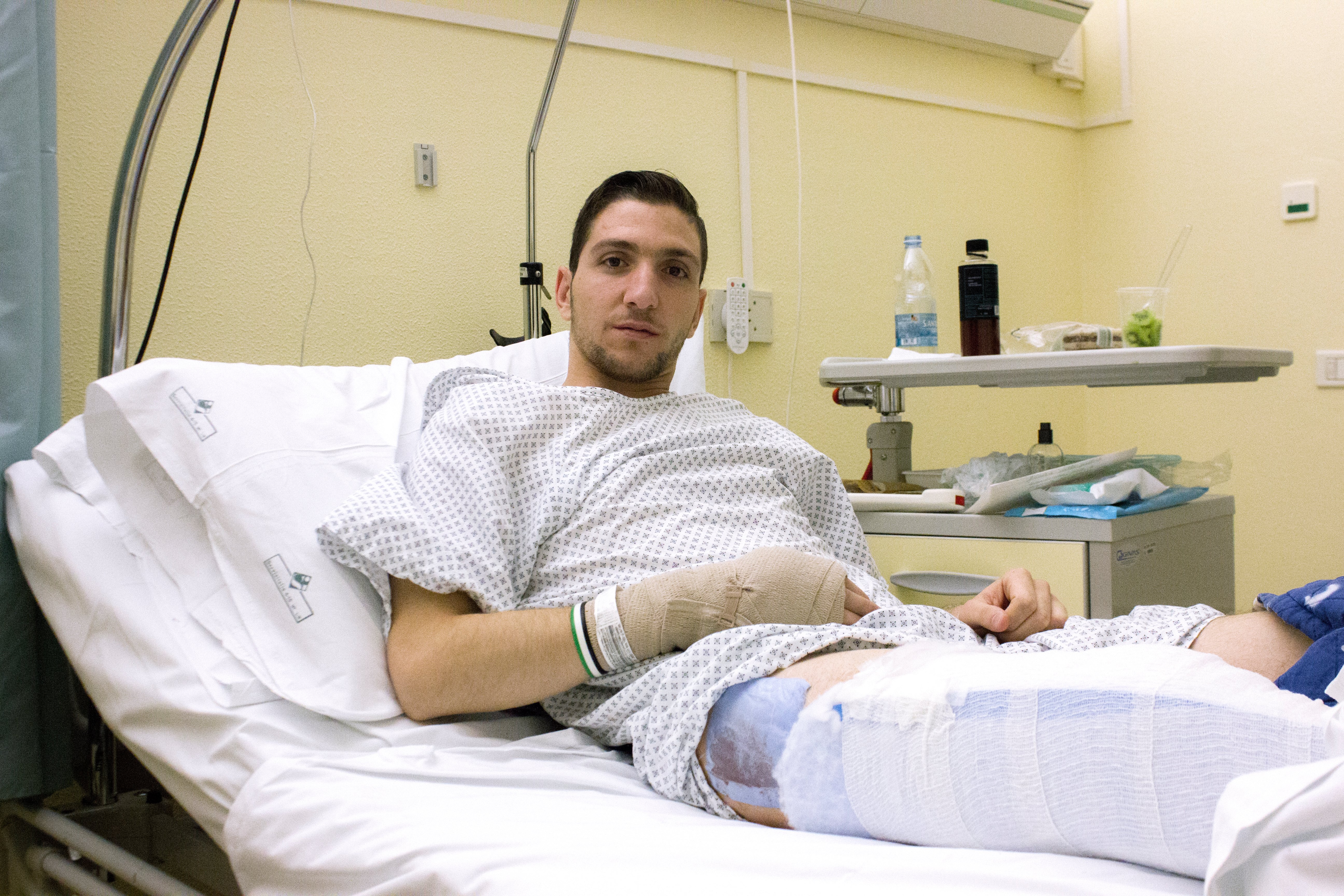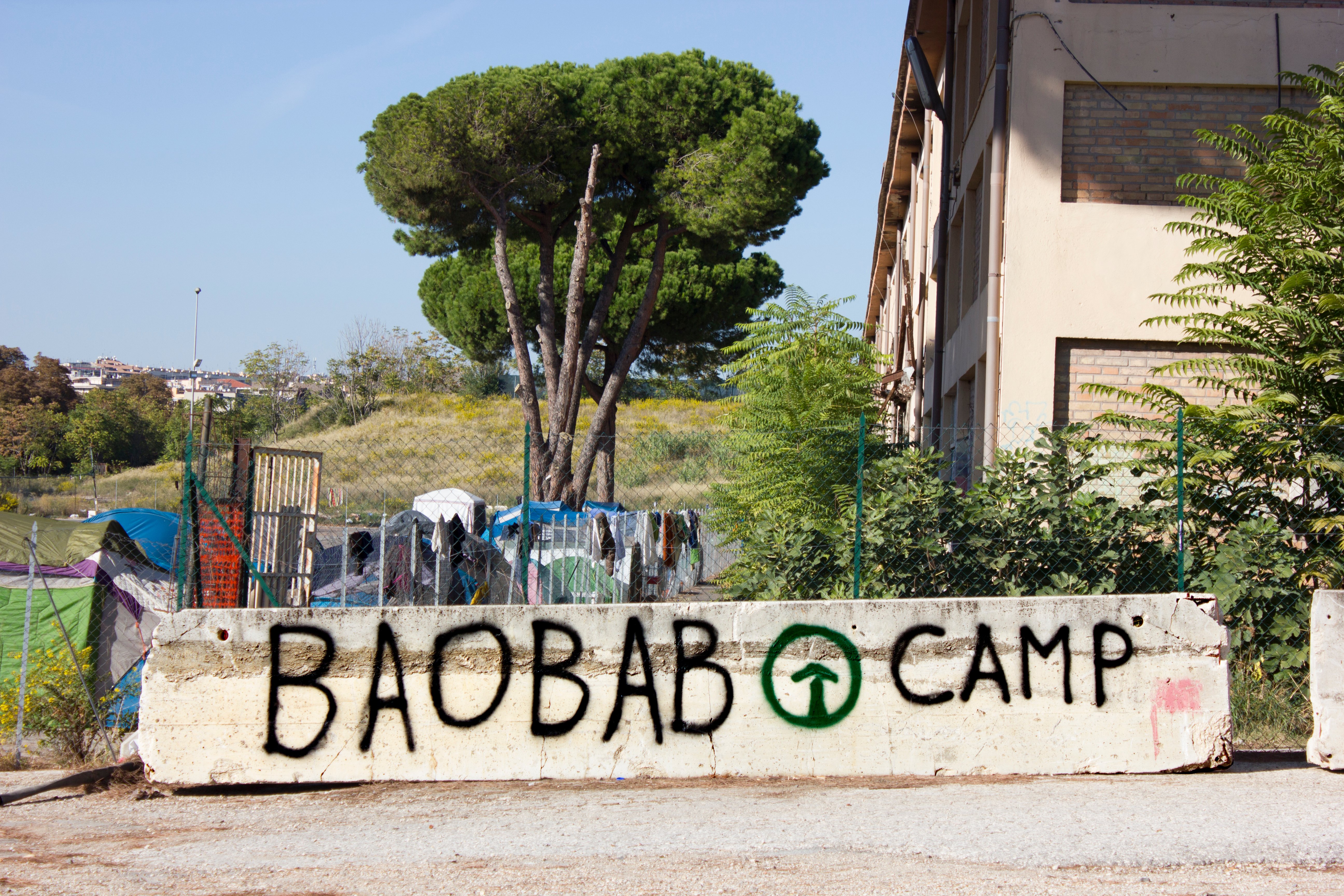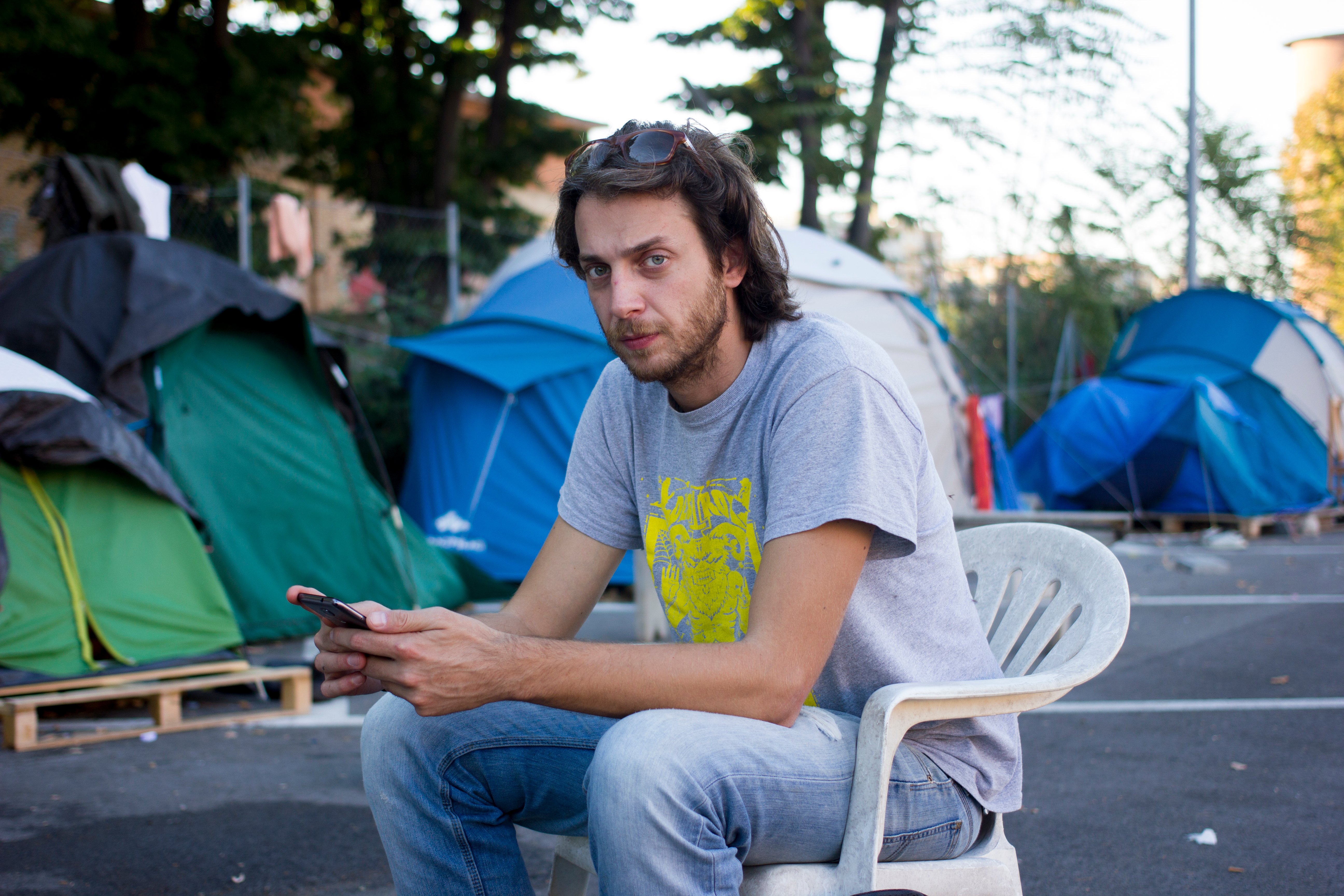When Anas Obeid was deported from Germany and landed at Milan’s Malpensa airport, the wound in his leg was still bleeding.
German police had woken him up at 4 that morning, 22 September, in the refugee accommodation centre where he was staying in the northern Bavarian town of Bamberg. They put him in the back of a van with metal grates in the windows, and drove him two hours to the airport in Munich.
The blood had soaked through his trousers during the ride, as German police discovered during a pre-flight security check. They called the airport doctor who insisted Anas was not fit for travel and should instead be in a hospital.
“Let him get treatment in Italy,” Anas remembers the officer overseeing his deportation saying before they put him on the plane.
Anas, a 27-year-old Syrian refugee, had not committed a crime so much as run afoul of a regulation he did not even know existed before arriving in Europe in December 2015. Under a European Union law known as the Dublin Regulation, he should have applied for asylum in the first country he arrived and was registered in. But Anas had waited to request refuge, and now he was being sent back to Italy, where he had landed after being rescued from an over-packed, wooden fishing boat off the coast of Libya along with 500 other people and taken to the island of Lampedusa.
Already injured from his time in Syria, instead of being taken to a hospital when he disembarked in 2015, Anas was taken for interrogation. The Italian police inspector questioning him wanted to know where he had come from and who he had met and interacted with from the time he left Syria until he reached Italy.
“I gave them everything; all the names I remembered, telephone numbers. Everything. They told me, ‘You’re a terrorist’,” said Anas. “I told them that I wasn’t, and they told me to give them my fingerprint to make sure. This fingerprint ruined my life.”
“Dublined”
Since 2014, more than 600,000 people have crossed the Mediterranean Sea from Libya to Italy. Many – like Anas – have fled wars and brutal dictatorships, but even those who make the crossing out of economic desperation often claim asylum once reaching Europe – even if many of their claims will ultimately be rejected.
The EU asylum process is governed by the Dublin Regulation, which requires people to apply for protection in the first country they enter. But many don’t want to remain in Italy or other southern European countries, such as Greece, where most asylum seekers arrive.
Social support systems in these countries are weak compared to northern Europe and there are high levels of unemployment even among citizens. New arrivals also often have connections elsewhere – family and friends who came before them – that encourage them to move on.
But once someone is registered as having arrived in one country, and their fingerprint is taken, they cannot apply for asylum anywhere else – barring a few exceptions. Their fingerprint is entered into a database that is searchable by police throughout the EU.
If they apply for asylum in another country, their fingerprint will come up, their claim doesn’t have to be considered and they can face deportation back to the country where they were first registered. Those who are sent back are referred to as having been “Dublined”.
As political attitudes in Europe have shifted against asylum seekers and refugees, the number of deportation requests under Dublin has skyrocketed – particularly to Italy. People are separated from friends and sometimes family in communities where they have started to build new lives.
Back in Italy, they face a cold reception. Even vulnerable cases – like Anas – are often left without support in a country where they never intended to stay.

Forced from Syria
Anas’ journey to Europe began in 2014 on a staircase outside of his family’s home in eastern Ghouta, an opposition-held suburb of Damascus that has been under siege since 2013.
“I was going out to get some things. When I stepped on the stairs, I saw the sniper right in front of me,” Anas recalled. “I was on the stairs, and the sniper was shooting at me.”
Two of the sniper’s bullets entered Anas’ right shoulder just above the collarbone; two more punctured his chest, narrowly missing his heart; several struck his left arm; and two hit his right leg.
Miraculously, all of the bullets exited his body without critically injuring him, except for the two in his leg. Those exploded into shards that ripped through his muscle and flesh and lodged in his femur.
There was no anaesthesia for Anas’ first surgery in eastern Ghouta, and there were no trained doctors either. In a video he showed me on his mobile phone, Anas lies on a gurney on his side under a surgical sheet with his right leg exposed. There’s a long incision from just below his hip to the top of his knee.
The camera pans from the bloody, open wound to Anas’ contorted face and then to a friend – a carpenter by trade – standing over him wearing scrubs and holding surgical instruments. The friend raises his hands slightly, as if giving a small shrug, and smiles sheepishly as the camera settles on his face and the video ends.
“I had four operations in Syria after I was injured,” Anas said. Despite the best efforts of the amateur doctors in eastern Ghouta, his leg became infected and swollen. “Every morning there would be puss on my bed. Not blood. Yellow puss. The smell was terrible. I told [my family] I had to leave.”
“Go sleep in the street”
Anas escaped from eastern Ghouta through an underground tunnel and crossed the border into Lebanon – all the time walking with crutches on his injured leg. From Lebanon, he flew on his brother’s passport to Algeria, crossed the desert into southern Tunisia and entered Libya.
Along the way, he stopped for months at a time to have more operations when the infection in his leg became inflamed. After nine months in Libya, he found a smuggler who put him on a boat to cross the sea, and landed in Lampedusa.
“I was injured and bleeding,” Anas said. “I just wanted to get treatment and apply for refugee status.”
After the police took his fingerprint and released him from the interrogation, Anas began asking other refugees about where he should go for medical help. The answer he received was Sweden. A marathon of ferries and trains ensued before he finally reached Stockholm: “I arrived in the capital and collapsed on the ground.”
He was taken in an ambulance to the hospital where he stayed for a week. While there, two Swedish police officers came and asked if he wanted to apply for asylum. When they took his fingerprint, it came up in the EURODAC database that is used to keep track of asylum seekers and people who cross Europe’s borders irregularly.
Nine months later – after being passed from hospital to hospital because of an antibiotic resistant MRSA infection in his leg – Anas was told that he’d be sent back to Italy.
Instead of waiting for deportation, he absconded and made his way to Germany. He entered on 10 November, 2016, and started another round of hospitals and surgeries until he was deported, despite having a letter from a doctor saying that his medical state was so severe he should remain in Germany for treatment.
When Anas arrived at the airport in Milan, the police took his fingerprints again and a picture and gave him some paperwork before telling him he could leave.
“I asked them where I should go. I was bleeding. Really, there was blood everywhere on my pants,” said Anas. “They said, ‘Go sleep in the street’. I didn’t have any money. I couldn’t sleep in a hotel. Where was I supposed to sleep?”
Evading deportation
In a 2016 report, Human Rights Watch called the forcible transfer of asylum seekers back to their first country of arrival “inefficient and inhumane.” But, that hasn’t stopped the requests from piling up, especially as government policies have become increasingly harsh in the face of a right-wing backlash against migration.
In 2015, Italy received around 25,000 incoming transfer requests. In 2016, the number jumped to almost 65,000.
The majority of transfers, however, never end up being carried out. Despite the 65,000 requests, only 4,061 people were sent back to Italy in 2016. Many people abscond before authorities can act and the transfers are expensive and logistically complicated to organise.

Those who evade deportation either move to another European country and try to apply for asylum again – despite the fact they’ll face the same result – or they try to fade into communities of undocumented people and avoid appearing on the official radar.
A cold reception
For people who are sent back, the indifference of the police officers who greeted Anas when he arrived in Milan is not at all uncommon.
“The situation in Italy is just really random,” said Camilla Hagen, a senior legal advisor for the Danish Refugee Council (DRC). “You can be lucky and you can get to a centre immediately… but you can also have all these other kinds of situation where you get no assistance or a little bit of assistance.”
In a project with the Swiss Refugee Council, the DRC spent a year monitoring reception conditions for Dublin returnees in Italy, especially focusing on vulnerable cases.
The report on the project concluded: “It cannot be guaranteed that families and persons with specific reception needs who are being transferred to Italy under the Dublin III Regulation are being received adequately and in respect of their basic human rights.”
Once back in Italy, people can either continue their asylum process, if they started one before they left, or apply for the first time and enter the reception system for new arrivals, which provides housing up to six months after they receive a final answer to their claim.
But, they are largely left on their own to take care of themselves while figuring out what options exist and how to access Italy’s limited services.
Trying again
Even after they are sent back, many asylum seekers don’t want to stay in Italy. I met Bassam, a 24-year-old Palestinian refugee from Gaza – who asked I use only his first name – at a volunteer run camp called the Baobab Experience in Rome.
Baobab has been around since 2003 and has morphed along with the changing dynamics of the migration crisis over the years. It was housed in a building until a police eviction in December 2015. Now, the camp is a collection of tents in an isolated parking lot behind Tiburtina train station on the outskirts of the city.
On a brisk mid-October morning, Bassam and I stood outside the tent where he had spent the night. He had been sent back from France the day before and arrived at Rome’s Fiumicino airport. “They just left me on the street,” he said of the police who registered his return. “I don’t know anything about Rome. They just told me to leave.”
After arriving from Libya in December 2016, Bassam spent four months in Italy. “They don’t put us in good places,” he said, referring to the reception centre he had been assigned to when he first arrived. “They don’t provide education… Italy is no good.”
Poor living conditions and services in reception centres is one of the main reasons people end up in Baobab, according to Roberto Viviani, president of the association that manages the camp. Once here, many decide to try to make it to northern Europe where they’ve heard conditions are better. Viviani sometimes sees them again in the camp once they’ve been sent back.
“Psychologically, they are devastated,” he said. “Imagine a nine-month trip, escaping from dictatorship, passing through the human trafficking in Sudan, arrived in Libya, tortured, sexual torture, psychological torture, passing the Mediterranean Sea, survived the Mediterranean Sea, arrived in Italy, arrived to the other states of northern Europe... You think that you have paid your bill to destiny and then you are sent back.”

Despite the trauma of being deported and left on the street, Bassam was undeterred. “I want to go back to France today,” he said. “I don’t want to stay in Italy.” His plan was to get his bearings, take a train to the north and cross the border again.
Less than 72 hours later, I received a message. He had made it back to France.
Rethinking Dublin?
The Dublin rules have long been criticised by migration advocates and governments alike. Between 2014 and 2016, Italy stopped fingerprinting every new arrival, and for a period of time, Germany and Sweden effectively suspended Dublin procedures for people escaping the Syrian war.
There is broad consensus that the protocol does not equitably distribute the responsibility of processing asylum requests among the EU’s 28 member states and that it has failed to prevent people from moving to their preferred destinations after landing in Europe.
What it does do is push people towards becoming undocumented and increases the psychological stress of their long and arduous journeys. It also extends the length of time it takes for refugees to receive protection, and only then in a country where they didn’t want to stay.
In November, the European Parliament endorsed a proposal to overhaul the Dublin Regulation. At the foundation of the reform is a more equitable distribution of responsibility for asylum seekers among EU member states.
Importantly, it would do away with the requirement for people to apply for asylum in the country where they first arrive and allow them to choose between four member states as their destination to live, unless they could prove a strong family connection in another country where they would want to go.
Yet it is far from certain that the proposed changes will pass into law anytime soon. A number of eastern European countries, including Hungary and Poland, with right-wing governments, strongly oppose the reforms and will likely stonewall progress in the next step of the legislative process.
In the meantime, tens of thousands of asylum seekers – like Anas – are having years of their lives shaped by a single fingerprint.
Losing time
Anas eventually found a hospital in Bologna, three hours south of Milan, to treat his leg. That’s where I met him one afternoon in late October. I arrived as he was just awaking from a morphine induced slumber. We talked for close to three hours. As the late afternoon sunshine outside faded to night, Anas’ despair increased.
Initially when a doctor in Germany told him he wanted to amputate his leg, Anas walked out of the hospital and found somewhere else that would treat him. Now, amputation sounds like a relief.
Despite having made it so far and crossed so many borders to try to save his leg – and maybe also his life – Anas feels like he hasn’t made it anywhere at all. “I’ve lost two years of my life between Sweden and Germany,” he said. “My only crime was that I gave my fingerprints.”
(TOP PHOTO: An applicant is fingerprinted and the results are registered in the Eurodac system. CREDIT: Peter de Ruiter/UNHCR)
er/oa





